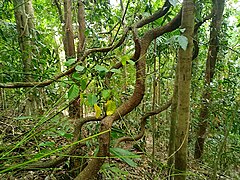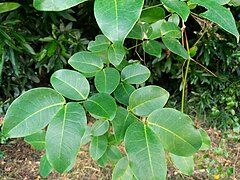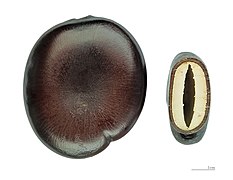Entada phaseoloides
| Entada phaseoloides | |
|---|---|

| |
| Pod specimen | |
| Scientific classification | |
| Kingdom: | Plantae |
| Clade: | Tracheophytes |
| Clade: | Angiosperms |
| Clade: | Eudicots |
| Clade: | Rosids |
| Order: | Fabales |
| Family: | Fabaceae |
| Subfamily: | Caesalpinioideae |
| Clade: | Mimosoid clade |
| Genus: | Entada |
| Species: | E. phaseoloides
|
| Binomial name | |
| Entada phaseoloides | |
| Synonyms[2] | |
|
20 synonyms
| |
Entada phaseoloides, commonly known in English as the matchbox bean or St. Thomas' bean, is a large twining vine or liana in the pea and bean family Fabaceae, native to a broad area of Asia-Pacific, from China to northern Australia and the southwestern Pacific.
It is also known as gugo in the Philippines, where the bark sap is used as a traditional shampoo.[3][4]
Description
[edit]Entada phaseoloides is a large woody liana whose stems may reach up to 18 cm (7.1 in) diameter. They are dark brown with a course bark, and are flattened laterally and spirally twisted. The bipinnate leaves are up to 25 cm (9.8 in) long, with 1 to 2 pairs of leaflets, each of which is again divided into 1 to 2 pairs of "pinnules" (leaflets). The pinnules are somewhat leathery, asymmetrical or oblique, and measure up to 10 cm (3.9 in) long by 5 cm (2.0 in) wide.[5][6][7]
The inflorescences take the form of a spike measuring around 25–30 cm (9.8–11.8 in) long, carrying numerous sessile flowers. The individual flowers are very small, measuring only about 1.2 mm (0.05 in) diameter. There are five petals, green with a reddish base, measuring about 3–4 mm (0.12–0.16 in) long, stamens about 7 mm (0.28 in) long.[5][6][7]
In contrast to the tiny flowers, the fruit of this species is a very large, flattened, woody pod or capsule, measuring about 1–1.2 m (3 ft 3 in – 3 ft 11 in) long and 12 cm (4.7 in) wide. They are usually slightly curved longitudinally, and have about 12 segments, each containing one seed.[5][6][7]
The seeds are lens-like, glossy brown and smooth, measuring about 5–6 cm (2.0–2.4 in) wide and long, and 1–1.5 cm (0.39–0.59 in) thick.[5][6][7]
Distribution
[edit]The matchbox bean is native to a broad area from mainland Asia, through Melanesia to northern Australia and the western Pacific. Regions and/or countries include Tibet, south and southeast China, Japan, Mainland Southeast Asia, Malesia, Papuasia, northern Australia, New Caledonia, Vanuatu, Fiji, and Hawaii.[2]
Taxonomy
[edit]This species was first described in 1754 by the father of modern taxonomy, Carl Linnaeus, who gave it the binomial name Lens phaseoloides.[2] In 1914 the American botanist Elmer Drew Merrill, who was at that time halfway through his 22-year stint of working in the Philippines, published a review of the species, in which he transferred it to the genus Entada.[8]
Uses
[edit]Filipinos have been traditionally using gugo before commercial shampoos were sold in stores. The shampoo is obtained by soaking and rubbing the bark of the vine gugo (Entada phaseoloides),[3][4] producing a lather that cleanses the scalp effectively. Gugo is also used as an ingredient in hair tonics.[9] A study by the Philippines Department of Science and Technology found that gugo prevents hair fall because it stimulates micro circulation in the blood vessels.[10]
Tongans use the seeds of this plant (known as paʻanga) as ankle decorations for their traditional kailao dance as well as for use in an ancient game called lafo. The paʻanga is also the name given to their currency.[11][12]
Gallery
[edit]-
Stems, typical appearance
-
Foliage
-
Inflorescences
-
Pod (fruit)
-
Seed, entire and cross-section
References
[edit]- ^ "Species profile—Entada phaseoloides". Queensland Department of Environment and Science. Queensland Government. 2022. Retrieved 11 March 2024.
- ^ a b c d "Entada phaseoloides (L.) Merr". Plants of the World Online. Royal Botanic Gardens, Kew. 2024. Retrieved 11 March 2024.
- ^ a b Diaz, Eden C. (1990). Home Economics, Practical Arts and Livelihood Education for College: Book Two. Rex Bookstore, Inc. p. 75. ISBN 978-971-23-0795-9. Retrieved 18 June 2021.
- ^ a b Salas, Kinny (21 March 2014). "Thick, lush, sexy hair from drugstore products". Philippine Daily Inquirer. Archived from the original on 25 March 2014. Retrieved 18 June 2021.
- ^ a b c d Cowan, R.S. (2022). Kodela, P.G. (ed.). "Entada phaseoloides". Flora of Australia. Australian Biological Resources Study, Department of Climate Change, Energy, the Environment and Water: Canberra. Retrieved 12 March 2024.
- ^ a b c d "Entada phaseoloides (Linnaeus) Merrill". Flora of China (eFloras). Missouri Botanical Garden, St. Louis, MO & Harvard University Herbaria, Cambridge, MA. Retrieved 12 March 2024.
- ^ a b c d F.A.Zich; B.P.M.Hyland; T.Whiffen; R.A.Kerrigan (2020). "Entada phaseoloides". Australian Tropical Rainforest Plants Edition 8 (RFK8). Centre for Australian National Biodiversity Research (CANBR), Australian Government. Retrieved 12 March 2024.
- ^ Merrill, E.D. (1914). "An enumeration of the plants of Guam". The Philippine Journal of Science. 9 (C): 86. Retrieved 11 March 2024.
- ^ Gonzales, Lucas L.; Quimio, Jr., Marcos J.; Calinawan, Rogelio. "Response of gugo to differing potting media" (PDF). Canopy International. 27. Department of Environment and Natural Resources: 3. ISSN 0115-0960. Retrieved 18 June 2021.
- ^ Enriquez, Marge C. (3 May 2011). "Is lauat the new, natural solution to falling hair?". Philippine Daily Inquirer. Archived from the original on 24 September 2015. Retrieved 18 June 2021.
- ^ Lim, T.K. (2012). Edible Medicinal And Non-Medicinal Plants: Volume 2, Fruits. Springer Science & Business Media. pp. 627–633. ISBN 978-94-007-1764-0.
- ^ Spread, Patrick (2013). Support-bargaining, Economics, and Society: A Social Species. Routledge. pp. 200–201. ISBN 978-0-415-64112-8.
External links
[edit]- View a map of herbarium collections of this species at the Australasian Virtual Herbarium
- View observations of this species on iNaturalist
- See images of this species on Flickriver





